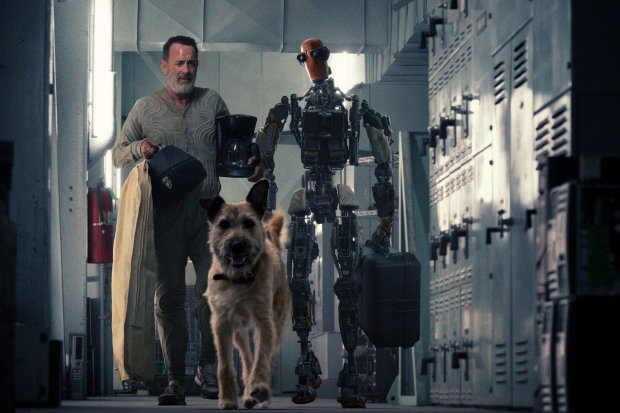Among the actors making publicity rounds in the run up to the Oscars on March 10 is a 7-year-old border collie named Messi, who co-stars in best picture nominee “Anatomy of a Fall.”
Called Snoop in the film, he traveled from France last week to attend the luncheon for Oscar nominees. Never one to let a good marketing opportunity go to waste, the Academy shared a post on social media with photos and a jokey caption: And the Oscar for bestest boi goes to Messi from ‘Anatomy of a Fall.’
And the Oscar for bestest boi goes to Messi from 'Anatomy of a Fall.' #Oscars pic.twitter.com/V5a1JCyACs
— The Academy (@TheAcademy) February 13, 2024
He seems to have the right kind of disposition to tolerate the noisy, sweaty, chaotic environments where Oscar campaigning is unfolding.
But he’s not the first dog to melt Oscar hearts.
A terrier named Uggie was featured in 2011’s “The Artist,” a black-and-white comedy about a silent film actor and the starlet he falls for. The movie won five Oscars, including best picture. Uggie’s presence in the film seemingly inspired the creation of the short-lived Golden Collar Awards. To the best of my knowledge, they existed for just a single year in 2012.
A separate, unrelated award called the Palm Dog has been around since 2001 and is given to the best canine performance at the Cannes Film Festival (riffing on the fest’s top prize the Palme d’Or). Uggie, who died in 2015, and Messi were both winners in their respective years.
But “Anatomy of a Fall” does something more interesting — Messi isn’t there as a gag or simply to be cute — and that got me thinking about dogs and cats that aren’t merely part of the background but function as important supporting players.
We have full, complex relationships with our animals. They want to know what we’re doing, what we’re eating, why we’re not out of bed yet. They know when we are sick or upset, and we know the same about them. They are part of the family — some have a sense of humor! — and we form mutual and deeply emotional connections with them. Our pets bear silent witness to our most intimate moments. They see it all.
This relationship rarely shows up on screen, but “Anatomy of a Fall” gets closer than most. Snoop is the family dog, ready to play fetch and trek through the snow. Doesn’t like baths much. He is a steady, alert companion to a young boy with a visual impairment. And it is Snoop who first notices that something is amiss when the pair return home from a walk: A man lies prone on the ground, blood pouring from his head. It’s the boy’s father. Soon, his mother will be charged with murder. As the trial unfolds, Snoop’s presence at home helps the boy sort through his theory of what really happened. The dog is an essential part of the film’s emotional language, as well.
“It’s a true profession,” Messi’s owner and trainer Laura Martin Contini told IndieWire. “Any time you see a dog or an animal on screen, it‘s the result of a long process of preparation, even if the dog is just laying down.”
Adding animals to a scene means adding time, which means adding money to the budget. Their absence is usually a matter of practicality in a business that is forever looking for cutbacks. So when they do show up, it can feel momentous.
I’ve always been partial to the way the Coen Bros. incorporated a cat into 2013’s “Inside Llewyn Davis,” which stars Oscar Isaac as a lonely, morose, ’60s-era folk singer. Early in the film, an orange cat makes a running leap onto his sleeping chest as dawn breaks, offering a curt meow and then some purring. Yes, you think, this is how cats behave. The cat belongs to the Gorfeins, who let Llewyn crash at their apartment the night before. But when he goes to leave, he inadvertently lets the cat escape out the front door, which locks behind them both. His only option is to carry the cat around with him, which includes a memorable sequence on the subway. The cat is transfixed by the view out the window, as the tunnel zips by.
“The film doesn’t really have a plot. That concerned us at one point,” said Joel Coen when the movie premiered. “That’s why we threw the cat in.” They would regret that choice, calling it “nightmarish.” On an episode of NPR’s “Fresh Air,” they recalled their animal trainer telling them “a dog wants to please you; a cat only wants to please itself. It was just long, painstaking, frustrating days shooting the cat.”
Sometimes a film gets it all wrong. In 2021, Tom Hanks starred in the little-seen, weirdly upbeat apocalyptic Apple TV+ movie “Finch,” about a man who is dying. The atmosphere is unlivable, so his existence is spent in a bunker. His only companion is a scruffy dog named Goodyear and he builds an android to look after his mutt when he’s gone. But Goodyear has no discernible personality. It’s conspicuous and disappointing.
American films are usually terrible at this sort of thing. Directors outside the U.S. tend to generate more interesting results.
In the 2016 Colombia drama “Perros” (“Dogs”), John Leguizamo plays a man serving time for a murder. The prison is a brutal environment, and his emotional survival becomes dependent on a sweet brown dog that also lives there. In interviews, Leguizamo said the dog wasn’t easy to work with. But you would never know it watching her cheerful interactions on screen amidst the bleak concrete setting.
Perhaps my favorite is a modest 2015 film from Chile called “Perla” (“Pearl”), which imagines the inner life of a street dog in Santiago named Pearl. All she wants is human companionship and her running monologue is so hopeful and plaintive. Writer-director Sergio Castilla cast his own dog to play Pearl. He adopted her a few years prior, after finding her wounded on a street near his home. Alas, I can’t seem to find any streaming options for the movie.
Human-animal bonds captured on screen are an illusion. A performance like any other. And yet you never question it in “Anatomy of a Fall.”
“I always leave room for improvisation for the dog so that he can suggest things and make it natural,” Messi’s owner told GQ.
Off set, he is resolutely dog. “We live in the countryside and Messi loves going for walks and playing ball. For him the ball is sacred! Otherwise at home he is a fairly calm dog. The quiet force.”
Nina Metz is a Tribune critic.




